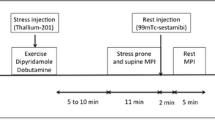Abstract
In this study, our aim was to assess the coronary flow reserve (CFR) by performing the adenosine stress 99mTc-MIBI single-photon computed tomographic (SPECT) myocardial perfusion imaging in patients with hypertension. 47 hypertensive patients with normal coronary angiography were divided into 2 groups, defined by the presence (LVH, n = 22) and absence (non-LVH, n = 25) of left ventricular hypertrophy with 17 normal cases as controls. All patients were administered the adenosine stress-rest 99mTc-MIBI scintigraphy. 0.14 mg/kg/min adenosine was administered by continuous infusion for 6 min. We found that adenosine-induced myocardial ischemia was present in 26 cases (55.3 %) with 87 segments (20.6 %) showing abnormal distribution in the hypertensive group versus a single case (5.9 %) (χ 2 = 31.12, P < 0.001) and segment (0.7 %) (χ 2 = 32.90, P < 0.001) in the control group by SPECT perfusion. In the LVH group, 17 cases (77.3 %) and 67 segments (33.8 %) of myocardial ischemia were present. In the non-LVH group, there were 9 cases (36.0 %) (χ 2 = 8.06, P < 0.001), 20 segments (8.9 %) (χ 2 = 40.13, P < 0.001). There was a significant decrease in coronary reserve in the hypertensive groups following adenosine infusion with a fourfold decrease in cases and a sixfold decrease in segments (P < 0.001). Our study suggests that assessing CFR by the 99mTc-MIBI adenosine stress by SPECT imaging is a relatively easy, safe, and non-invasive test in patients with hypertension. We noted a decrease in CFR in patients with hypertension. This decrease was especially remarkable for hypertensive patients with LVH. This study shows that administering the 99mTc-MIBI adenosine stress by SPECT imaging is a safe, simple, and non-invasive test for detecting CFR in patients with hypertension.


Similar content being viewed by others
References
Galderisi, M., Cicala, S., De Simone, L., Caso, P., Petrocelli, A., Pietropaolo, L., et al. (2001). Impact of myocardial diastolic dysfunction on coronary flow reserve in hypertensive patients with left ventricular hypertrophy. Italian Heart Journal: Official Journal of the Italian Federation of Cardiology, 2(9), 677–684.
Misawa, K., Nitta, Y., Matsubara, T., Oe, K., Kiyama, M., Shimizu, M., et al. (2002). Difference in coronary blood flow dynamics between patients with hypertension and those with hypertrophic cardiomyopathy. Hypertension Research: Official Journal of the Japanese Society of Hypertension, 25(5), 711–716.
Tsiachris, D., Tsioufis, C., Dimitriadis, K., Syrseloudis, D., Rousos, D., Kasiakogias, A., et al. (2012). Relation of impaired coronary microcirculation to increased urine albumin excretion in patients with systemic hypertension and no epicardial coronary arterial narrowing. The American Journal of Cardiology, 109(7), 1026–1030.
Di Carli, M. F., Charytan, D., McMahon, G. T., Ganz, P., Dorbala, S., & Schelbert, H. R. (2011). Coronary circulatory function in patients with the metabolic syndrome. Journal of Nuclear Medicine: Official Publication, Society of Nuclear Medicine, 52(9), 1369–1377.
Tzortzis, S., Ikonomidis, I., Lekakis, J., Papadopoulos, C., Triantafyllidi, H., Parissis, J., et al. (2010). Incremental predictive value of carotid intima-media thickness to arterial stiffness for impaired coronary flow reserve in untreated hypertensives. Hypertension Research: Official Journal of the Japanese Society of Hypertension, 33(4), 367–373.
Cortigiani, L., Rigo, F., Galderisi, M., Gherardi, S., Bovenzi, F., Picano, E., et al. (2011). Diagnostic and prognostic value of Doppler echocardiographic coronary flow reserve in the left anterior descending artery in hypertensive and normotensive patients. Heart, 97(21), 1758–1765.
Lonnebakken, M. T., Rieck, A. E., & Gerdts, E. (2011). Contrast stress echocardiography in hypertensive heart disease. Cardiovascular Ultrasound, 9, 33.
Antonios, T. F., Kaski, J. C., Hasan, K. M., Brown, S. J., & Singer, D. R. (2001). Rarefaction of skin capillaries in patients with anginal chest pain and normal coronary arteriograms. European Heart Journal, 22(13), 1144–1148.
Rizzoni, D., Palombo, C., Porteri, E., Muiesan, M. L., Kozakova, M., La Canna, G., et al. (2003). Relationships between coronary flow vasodilator capacity and small artery remodelling in hypertensive patients. Journal of Hypertension, 21(3), 625–631.
Ibrahim, T., Nekolla, S. G., Schreiber, K., Odaka, K., Volz, S., Mehilli, J., et al. (2002). Assessment of coronary flow reserve: Comparison between contrast-enhanced magnetic resonance imaging and positron emission tomography. Journal of the American College of Cardiology, 39(5), 864–870.
Lim, D. S., Kim, Y. H., Lee, H. S., Park, C. G., Seo, H. S., Shim, W. J., et al. (2000). Coronary flow reserve is reflective of myocardial perfusion status in acute anterior myocardial infarction. Catheterization and cardiovascular interventions: Official Journal of the Society for Cardiac Angiography & Interventions, 51(3), 281–286.
Bartel, T., Yang, Y., Muller, S., Wenzel, R. R., Baumgart, D., Philipp, T., et al. (2002). Noninvasive assessment of microvascular function in arterial hypertension by transthoracic Doppler harmonic echocardiography. Journal of the American College of Cardiology, 39(12), 2012–2018.
Eftekhari, A., Mathiassen, O. N., Buus, N. H., Gotzsche, O., Mulvany, M. J., & Christensen, K. L. (2011). Disproportionally impaired microvascular structure in essential hypertension. Journal of Hypertension, 29(5), 896–905.
Maret, E., Engvall, J., Nylander, E., & Ohlsson, J. (2008). Feasibility and diagnostic power of transthoracic coronary Doppler for coronary flow velocity reserve in patients referred for myocardial perfusion imaging. Cardiovascular Ultrasound, 6, 12.
Mahfouz, R. A., El Tahlawi, M. A., Ateya, A. A., & Elsaied, A. (2011). Early detection of silent ischemia and diastolic dysfunction in asymptomatic young hypertensive patients. Echocardiography, 28(5), 564–569.
Schafer, S., Kelm, M., Mingers, S., & Strauer, B. E. (2002). Left ventricular remodeling impairs coronary flow reserve in hypertensive patients. Journal of Hypertension, 20(7), 1431–1437.
Author information
Authors and Affiliations
Corresponding author
Additional information
Qiang Fu and Qian Zhang have contributed equally to this work.
Rights and permissions
About this article
Cite this article
Fu, Q., Zhang, Q., Lu, W. et al. Assessment of Coronary Flow Reserve by Adenosine Stress Myocardial Perfusion Imaging in Patients with Hypertension. Cell Biochem Biophys 73, 339–344 (2015). https://doi.org/10.1007/s12013-015-0600-1
Published:
Issue Date:
DOI: https://doi.org/10.1007/s12013-015-0600-1




